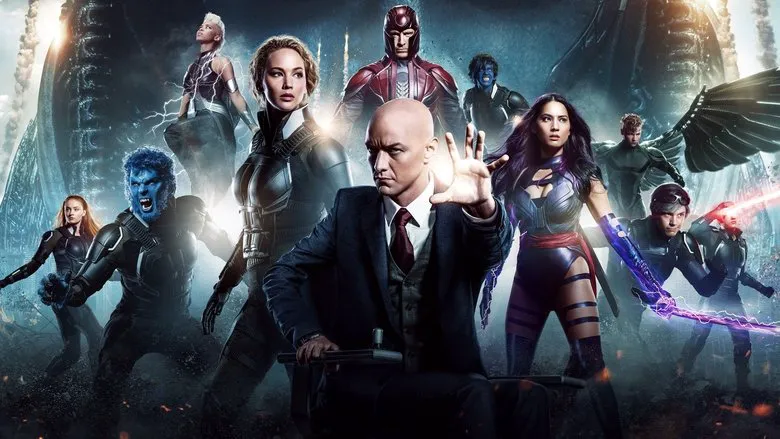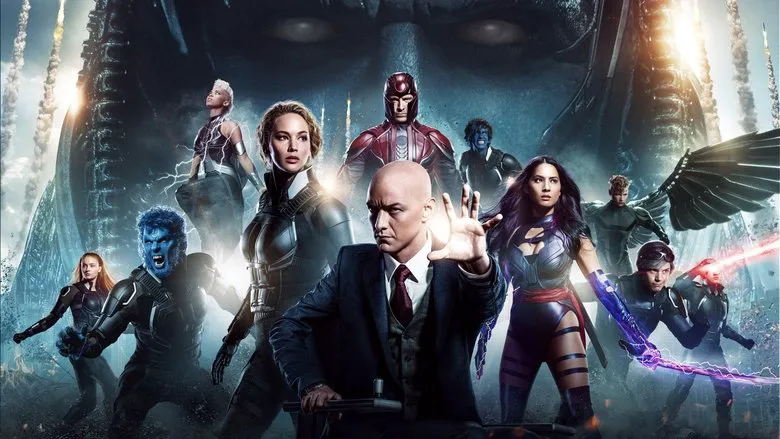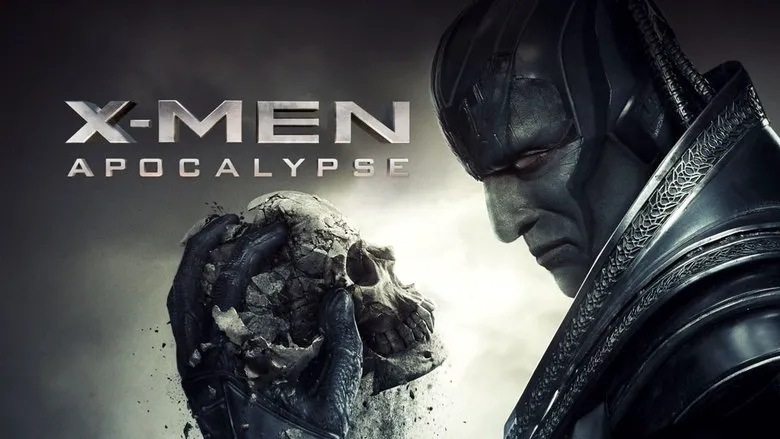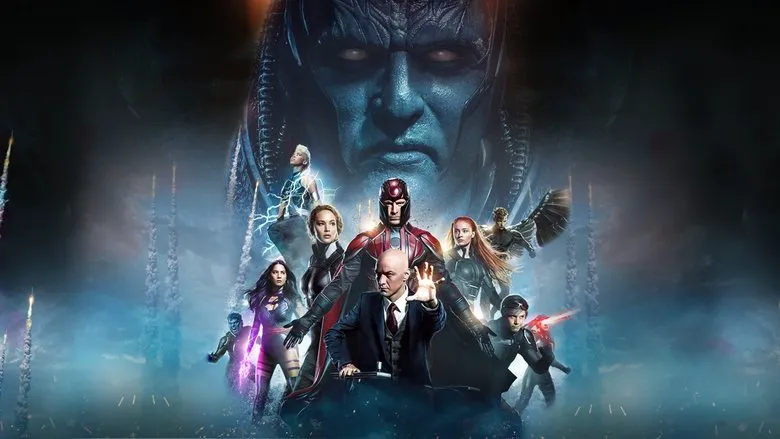X-Men: Apocalypse - A Blockbuster Battle for Mutant Supremacy
Once again, the epic saga of the X-Men unfolds on a grand cinematic scale, delivering a spectacular continuation that plunges a new generation of courageous heroes into a daunting confrontation against an ancient, formidable evil. The conflict at its heart is a timeless struggle between good and evil mutants, escalated to a global threat that tests the very fabric of existence.
The Resurrection of a Primeval Threat
Millennia before the modern era, in a time long forgotten, the first mutant, En Sabah Nur – later known as Apocalypse – was born. Endowed with an unparalleled array of extraordinary abilities, he honed his power over centuries through a disturbing ritual of reincarnation, absorbing the powers and life force of other mutants sacrificed to him. As his might swelled to near-godlike proportions, threatening to subjugate all life, humanity mustered a desperate rebellion, successfully imprisoning him within a monumental stone tomb deep beneath an Egyptian pyramid.
The dawn of the 1980s heralded a catastrophic awakening. A devoted cult, meticulously preserving ancient lore, unearthed En Sabah Nur’s resting place, inadvertently unleashing the ancient tyrant upon a vastly changed world. With a chilling resolve to purify and reshape civilization in his own image, he immediately set out to assemble an army of disgruntled and powerful mutants. Among his most significant recruits is the perpetually tormented Erik Lehnsherr, also known as Magneto (Michael Fassbender), who, after suffering an unimaginable personal loss, finds himself utterly disillusioned with humanity and ripe for Apocalypse’s extremist agenda. This burgeoning, world-threatening menace naturally draws the immediate attention of seasoned mutant leaders like Mystique (Jennifer Lawrence) and Professor Charles Xavier (James McAvoy), alongside a burgeoning younger generation of mutants, most notably the telepathically gifted Jean Grey (Sophie Turner).

Continuing a Storied Legacy
While Marvel Studios has been meticulously expanding its interconnected cinematic universe, 20th Century Fox diligently continued its substantial investment in the X-Men film series, a franchise rooted in one of Marvel’s most critically acclaimed and commercially successful comic book properties. “X-Men: Apocalypse” stands as the third pivotal installment in the prequel saga, which commenced with Matthew Vaughn’s highly praised “X-Men: First Class” in 2011. That film masterfully chronicled the initial, complex encounters between the future friends-turned-enemies, Professor X and Magneto, set against the volatile backdrop of the Cuban Missile Crisis. Building on this foundation, in 2014, director Bryan Singer returned to the helm, seamlessly orchestrating the reunion of the classic and new casts in the critically and commercially successful “X-Men: Days of Future Past.” Now, “Apocalypse” endeavors to fill in the crucial narrative gap, illustrating how beloved characters such as the stoic Cyclops (Tye Sheridan), the formidable Jean Grey (Sophie Turner), the ethereal Storm (Alexandra Shipp), and the agile Nightcrawler (Kodi Smit-McPhee) eventually joined the ranks of the X-Men. A key narrative question arises: how well does Singer navigate this installment without the iconic veteran performances of Patrick Stewart and Ian McKellen, whose elder portrayals of Professor X and Magneto previously anchored the franchise?
A Mosaic of Mutated Talents
Remarkably well, as it turns out. To fully appreciate the intricate tapestry of “Apocalypse,” one must approach it from a precise analytical perspective. In essence, this new “X-Men” film functions much like a complex cinematic mosaic, composed of numerous individual pieces. On their own, some of these components might indeed appear to lack singular strength or impact. However, the true brilliance of the film becomes apparent when these diverse elements are meticulously brought together, interacting in a synchronized manner. The synergistic result is undeniably greater than the sum of its individual parts, forming a cohesive and compelling whole.

The Antagonist as a Catalyst
Consider the film’s central antagonist, En Sabah Nur, known ominously as Apocalypse. Superficially, he might be perceived as a rather stereotypical Hollywood tyrant, his primary appeal stemming from his vast and varied repertoire of superpowers and his somewhat outlandish, heavily costumed appearance (one can’t help but feel for Oscar Isaac, visibly burdened by layers of intricate makeup and prosthetic components!). It would be simplistic and perhaps unfair to isolate Apocalypse from the broader narrative and compare him solely to other generic supervillains. However, a deeper examination reveals his crucial role: his significance crystallizes not in his individual threat, but in how he interacts with and influences the other “pieces” of this cinematic puzzle. He doesn’t merely engage in cliché villainy; rather, he serves as a potent catalyzing force. He empowers Storm, igniting her pivotal journey within the X-Men universe, and more profoundly, he provokes Magneto, forcing him to confront deeply existential questions: “Is there anything left in this world truly worth fighting for, or is it merely better to dismantle the existing civilization and embark on a new creation?”
The Profound Internal Conflict
The central conflict of “X-Men: Apocalypse” extends far beyond a typical physical confrontation with its namesake villain. It delves into the harrowing psychological struggle tormenting Magneto, who finds himself agonizingly torn between his raw, unbridled rage stemming from the devastating loss of his newly found family, and his complex, lingering feelings of loyalty and camaraderie for his estranged friends within the X-Men. This profound internal struggle for Magneto would undoubtedly lack its compelling depth and emotional resonance if En Sabah Nur were not actively, manipulatively attempting to exploit his grief and guide him towards destruction.

Synchronization and Synergy
This principle of interconnectedness and synergy applies equally to various other elements within the film. Were they extracted from the intricate narrative mechanism meticulously constructed by screenwriter Simon Kinberg, they might appear as nothing more than unremarkable, isolated cogs. Yet, when meticulously reassembled and interlocked within the grand design, “Apocalypse” truly runs with the precision and effectiveness of a well-oiled Swiss watch. Fundamentally, the film itself serves as a mirror reflecting the very essence of the X-Men team. Individually, these heroes may not possess the singular, flashy charisma or mainstream marketability of, for instance, Earth’s Mightiest Heroes. However, as an ensemble, they demonstrate a far superior capacity for mutual complementarity than the disparate powers of Iron Man and Captain America. Their strengths and vulnerabilities weave together seamlessly, and when they unite in concerted action, their team is remarkably effective, well-balanced, and formidable. Unlike some other superhero assemblages that merely present a collection of powerful individuals sharing the same frame, the X-Men truly epitomize the concept of a cohesive unit.

Uneven Performances and Fan Fervor
However, it must be acknowledged that not all the gears in the intricate machinery of “Apocalypse” spin with equal force or occupy positions of proportional importance. For example, Psylocke (Olivia Munn), one of En Sabah Nur’s formidable Four Horsemen, is noticeably underutilized, contributing minimal dialogue and often appearing primarily to showcase her character’s athletic prowess in a revealing costume, wielding an impressive energy sword. Conversely, Evan Peters once again commands unwavering attention as the lightning-fast mutant Quicksilver. His scene, a meticulously choreographed sequence set to period-appropriate music, undeniably delivers the film’s most humorous, inventive, and visually spectacular moments, effortlessly stealing the spotlight with his quick wit and astonishing heroics. It becomes evident that director Bryan Singer plays favorites with certain characters, and consequently, not all dedicated fans of the franchise’s extensive character roster will be entirely satisfied with the allotted screen time or narrative arcs for their beloved heroes. This particular point of contention, however, tends to resonate more deeply in regions like America, where the expansive mythology and rich character history of the X-Men comics are more widely known and cherished by a dedicated fanbase.
A Comparative Landscape
When positioning “Apocalypse” amidst the recent cascade of high-profile superhero epics, it arguably emerges as a superior offering compared to “Batman v Superman: Dawn of Justice,” though it ultimately falls short of the compelling narratives found in “Captain America: Civil War.” Singer’s film surpasses the former due to its notably superior balance of thrilling adventure and well-timed humor, a more coherent and purposeful script, and a sweeping final battle where each individual hero distinctly contributes to the overarching victory rather than a single character dominating the entire conflict.
“Civil War” maintains its stronger standing primarily due to its more compelling psychological depth, its consistently sharper and funnier jokes, and a dramatic final battle that skillfully keeps viewers guessing which superhero will ultimately prevail. Furthermore, the physical confrontations and hand-to-hand combat sequences in “Civil War” are arguably more visceral and impactful than the long-range battles characterized by force fields and energy beams, which are more typical of “Apocalypse” due to the nature of the X-Men’s diverse powers. However, this aspect is largely inherent to the unique array of the X-Men’s superpowers, a fundamental characteristic that Bryan Singer could hardly have altered without fundamentally redefining the team itself.
Concluding Thoughts
Predictably, the film’s visual effects are consistently top-notch and undeniably spectacular, a testament to the colossal $230 million budget which clearly went beyond mere star salaries to craft stunning action and environments. The only truly disappointing performance, however, comes from Jennifer Lawrence as Mystique. She appears conspicuously bored and disengaged in a role that barely scratches the surface of her prodigious acting talent, reminiscent of the weary monotony she exuded in the later installments of “The Hunger Games” series. Yet, this is arguably less a specific issue with “X-Men: Apocalypse” itself, and more a melancholic reflection of Hollywood’s persistent struggle to fully capitalize on and utilize the immense potential of an actress who has been deservedly awarded an Oscar.